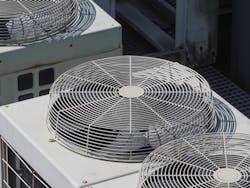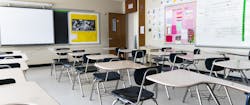With all of the relief funding provided to states and school systems in the past year, education institutions nationwide have access to unprecedented resources to help them enhance their learning environments.
But these funds won’t last forever.
After funds are allocated toward pre-award costs and debts, remaining dollars must be used to help schools reopen for in-person instruction, respond to health concerns, and support environments that thrive. If these funds aren’t used by their deadlines, they’ll be revoked.
The quality of education facilities has a significant effect on student performance. By employing more healthful indoor air, better lighting, and eco-friendlier cleaning, school districts can use these funds while supporting student achievement and schoolwide health. Putting these dollars to their best use may feel challenging, but with the right planning, schools and their facility partners can take action to carry out building upgrades that would have been considered unrealistic until recently.
Improved indoor air quality
Recent figures from the National Center for Education Statistics found that the average U.S. school building is 44 years old, and its average functional age (the relative age of the school based on the most recent major renovation) is 19 years.
Yet the average HVAC system has a life expectancy of only 12 to 15 years. This means that schools are relying on inefficient systems beyond their prime. Meanwhile, aging buildings experiencing structural issues and water leakage may be silently contributing airborne allergens like dust and mold to the problem, causing poor air quality that isn’t being alleviated.
Between years of deferred maintenance and the resulting compromised conditions of the building and air system, school buildings may be unknowingly circulating unhealthful air or not circulating any air at all.
As schools plan to earmark their funds to address indoor air quality issues, a performance assessment may be a good place to start. Indoor air quality professionals can evaluate a school’s risk level by assessing its HVAC control system, air flow, and air quality. They also can assess the temperature regulation problems that could be contributing to poor student achievement.
When classrooms are too hot or too cold, distractions arise and student performance suffers. Studies show that test score averages are higher in classrooms at 72 degrees Fahrenheit than classrooms at 61 or 81 degrees. Putting smart controls into place can help classrooms efficiently maintain comfortable temperatures conducive to learning.
Ideal temperatures are important for boosting concentration, but as far as air quality concerns go, heating and cooling take a back seat to the “V” in HVAC. The right ventilation is key to reducing airborne contaminants and asthma triggers as part of a healthful indoor environment. Stagnant air may cause respiratory problems when debris, pollutants, and contaminants linger in shared spaces. Inadequate ventilation fails to replace poor air with a healthier intake.
Only a sophisticated ventilation system can properly regulate the movement and quality of indoor air; unsealed air ducts or even open windows enable outdoor pollutants to seep in, especially in school facilities with poor outdoor air quality. Modern HVAC solutions can keep harmful air out while filtering in clean air and distributing it evenly and comfortably.
Schools can expand their approach further through a number of advanced disinfection technologies. UV-C lighting can virtually “zap” harmful bacteria out of the air, and dry hydrogen peroxide and needlepoint bipolar ionization can enhance air filtration and attack pathogens directly. Using these approaches with an existing HVAC system makes it easier to eliminate or filter out contaminants in the air.
Greener cleaning and disinfection
A major objective of federal Covid aid is to address the facility shortcomings found in many public schools. Classrooms and children are no strangers to sickness. In every season, germs and illness can spread among students and staff, lowering student performance and driving up administrative costs because of absenteeism. Schools can allocate relief funds to bring advanced cleaning and disinfection to school facilities not only as a pandemic response, but also for the long haul. Ensuring that these cleaning methods are environmentally friendly can help further protect occupant health.
The latest solutions in green cleaning are as effective in reducing and eradicating germs as the cleaners containing volatile organic compounds (VOCs), many of which are carcinogenic. The right natural and non-toxic products won’t contribute to side effects like respiratory irritation and asthma.
With a disinfection program, schools can go beyond routine cleaning to remove and reduce germs from surfaces and objects. Once surfaces are effectively cleaned of top-level debris and dirt, disinfectants can reduce and effectively kill pathogens on high-touch surfaces, providing advanced protection for students and staff. Even if a foreign bacteria or virus akin to Covid-19 is unknowingly brought to school, a thorough disinfection program will provide a better fighting chance to reduce the risk of spread.
Upgraded lighting
Improved learning conditions will help students who have experience learning loss during the pandemic. Inadequate conditions, such as poor lighting in classrooms, may create obstacles to learning. Poorly lighted spaces cause eyestrain and problems with focusing when students need their concentration most. A lack of adequate lighting also may trigger headaches and intensify stress levels, contributing to an environment that’s burdensome for students and teachers.
Even when lighting is sufficient, the right type of lighting is equally important to well-being and student achievement. Schools that incorporate more natural lighting into their hallways and classrooms can help create brighter, more optimistic environments.
Replacing exterior walls with large windows might not be feasible for structural and budgetary reasons, but intelligent, modern lighting can easily replicate the spectrum and benefits of natural light. School buildings of all ages can retrofit their lighting layouts and enhance school appearance with efficient lighting design. Long-lasting LED lights offer a more versatile style of light at lower levels of energy use, helping schools maximize student achievement while minimizing maintenance needs and costs.
Energy-efficient LEDs are safe to touch, even when in use. Their glassless bulbs are virtually indestructible, and their long lifespan means less orders from suppliers and less trips up the ladder. Plus, their mechanics don’t rely on harmful chemicals or gases, eliminating toxic exposure from the list of possible concerns. These advantages make smart lighting a valuable supplement to a well-ventilated environment.
Advanced energy infrastructure
To some decision-makers, there’s a concern that school budgets won’t be able to support the advanced changes made possible with Covid relief funds. Once the money is spent, will the existing budget be large enough to cover the bill on high-powered HVAC systems? If budget concerns are limiting progress (especially while the clock keeps ticking), strategic energy usage can provide some relief. Considering renewable energy enhancements can bring about change that pays for itself.
Even if the installation doesn’t not fit the guidelines of use for federal Covid relief funds, schools can use the momentum of this time to invest in additional infrastructure. Renewable energy in the form of solar and wind power can support community goals and provide the low-cost power that advanced learning environments need, without increasing budgets in the process.
As educators and future leaders return to the classroom, prioritizing their health and well-being has never been more vital. It’s up to education institutions to make the right call with the resources at their disposal. This window of time is the most opportune to bring about change that would otherwise be difficult to fund.
About the Author
Kevin Brown
Vice President
Kevin Brown is vice president, engineering, at ABM. He is a member of ABM’s Expert Advisory Council, which is composed of leading experts in infectious disease, industrial hygiene, and facility services. He serves on the board of the Energy Management Association (EMA) and several technical and standards committees for the American Society of Heating, Refrigerating and Air-Conditioning Engineers (ASHRAE).


